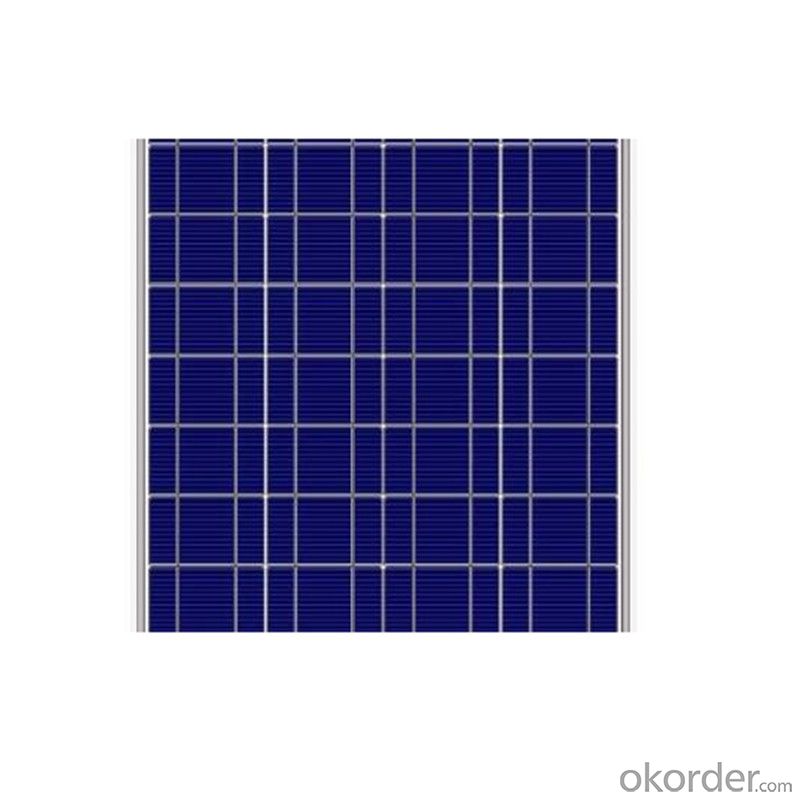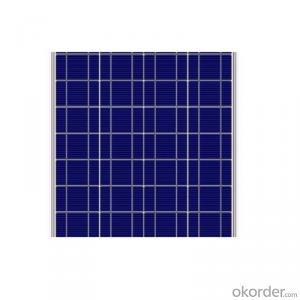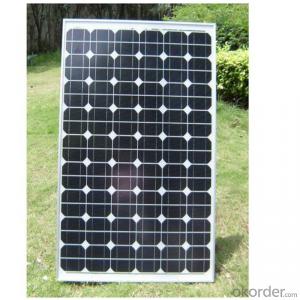200W 60 Cell Solar Photovoltaic Module Solar Panels
- Loading Port:
- China main port
- Payment Terms:
- TT OR LC
- Min Order Qty:
- 1000 watt
- Supply Capability:
- 500000 watt/month
OKorder Service Pledge
OKorder Financial Service
You Might Also Like
Item specifice
Instruction
1) Product name: solar panel / module
2) Solar cell: Mono-crystalline / Poly-crystalline / Amorphous
3) Tempered glass laminated with aluminum frame
4) Life time: 20 - 25 years
5) Temperature co-efficiency: A=+1,46mA B=-79mV, Rp/p=-0.43
6) Power specification at 1kW/m 2, AM 1, 5
7) Output cable: multi contact connectors
8) Construction:
a) Front: High-transmission 32mm tempered glass
b) Back: TPT
c) Encapsulant: EVA
9) Frame: aluminum
10) Certification: CE, TUV
Feature
1. Nominal 18V DC for standard output.
2. Cable connectors for easy installation.
3. Outstanding low-light performance.
4. Splendid aesthetic appearance and easy installation.
5. High efficiency & high stability.
6.Advanced EVA encapsulation system with TPT back sheet to improve product modules
7. Design to meet unique demand of customer.
8.25 year module output warranty.
9. Rugged design to withstands high wind pressure and snow load, easy installation.
10. Designed to comply with rigorous operating conditions, including test.
Images


Specification
Dimension (mm) | 1640*992*40 |
NO of Cells and Connections | 60(6x10) |
Weight(kg) | 18.5 |
Tolerance | 0~+5% |
Cell | Polycrystalline Cell 156 x 156 mm |
Operating Temperature | –40 °C to +85°C |
Max System Voltage(VDC) | 1000 |
Packing | 312PCS/20ft(H) Container |
FAQ
We have organized several common questions for our clients,may help you sincerely:
1). What’s price per watt?
A: It’s depends on the quantity, delivery date and payment terms of the order. We can talk further about the detail price issue. Our products is high quality with lower price level.
2). Can you tell me the parameter of your solar panels?
We have different series of cells with different power output, both from c-si to a-si. Please take our specification sheet for your reference.
3). How do you pack your products?
We have rich experience on how to pack the panels to make sure the safety on shipment when it arrives at the destination.
4). How long can we receive the product after purchase?
In the purchase of product within three working days, We will arrange the factory delivery as soon as possible. The perfect time of receiving is related to the state and position of customers. Commonly 7 to 10 working days can be served.
- Q:im aware i dont fully understand. but with what i do. if P = iv, and current changes with voltage, whats the point of changing either. if in any cicumstance, you end up with the same wattage, how does changing either effect a solar setup. (2v panel vs 24v)thanks in advance. explain in laymans if you can.
- The choice of solar panel voltage comes down more to what the panels will be connected to. You're right that power can remain the same at the different voltages. Higher input (panel) voltages are sometimes used in inverter systems to reduce the effect of voltage draw-down. 2v panels (about 20v open circuit) work well for charging 2v batteries, connected in parallel, through a charge controller. For use of a grid-tie inverter, higher input voltages are sometimes used to reduce the effects of draw-down. You want to select and wire (parallel vs. series) your panels based on the input voltage requirement of the load, whatever it may be.
- Q:I heard that solar energy has a lot of advantages but are there any drawbacks in using the solar panels?
- The largest drawback is the upfront investment you have to make for solar panels. There are some programs that allow you to finance the panels through your property assessment called PACE and leasing programs that can alleviate the large upfront cash outlay. Solar Panels have a lifespan of 30+ years. Since there are no mechanical parts, there is very little maintenance required. After 0-5 years, you will have to replace the inverter which converts the energy from DC to AC. This is a small cost in respect to the whole installation. The panels clean themselves well with just normal rain. With all the great federal and state incentives, the payback on solar is at it's all-time best. In Massachusetts, for example, the payback right now is 5 or 6 years -- then you would be making money for the next 25+. Another big potential drawback is that you must have the right site for solar to begin with. I'm a solar installer and I can tell you a lot of houses might not be right for solar. The best orientation is south, while southeast and southwest can work as well. The space must be unshaded and it would be best if it had few obstructions like chimneys, etc.
- Q:is this fact true? - its a limitation to solar panels during summer when it's in extremly hot countrie. I've heard it from my science teacher .. please give detail if you have any and any more benefits/limitations is welcomed .. Thank you :) !
- Solar okorder /... you'll notice that they have different curves for different temperatures. But they do still produce power, certainly. I have an array on my roof, and it still manages to max out the inverter on a hot summer day. But I do notice that the top row, which is hotter due to heat rising from those below, consistently puts out a few less watts than the bottom row. So more sun is certainly better; direct light is exactly what's needed. But hot panels due to poor air circulation or high ambient temperature does cut into efficiency. (Solar thermal, of course, is a different story)
- Q:Can solar panels be installed on historic buildings?
- Yes, solar panels can be installed on historic buildings. However, the installation process needs to be carefully planned and executed to ensure that it does not damage the historic fabric or compromise the architectural integrity of the building.
- Q:Can solar panels be installed on a telecommunications tower or antenna?
- Yes, solar panels can be installed on a telecommunications tower or antenna. In fact, many telecommunications companies are increasingly adopting this approach to power their equipment and reduce reliance on traditional energy sources. Solar panels can effectively generate electricity for the tower's operations, making it more sustainable and environmentally friendly.
- Q:Can solar panels be installed on a garage or carport?
- Yes, solar panels can be installed on a garage or carport. In fact, these structures often provide ideal locations for solar panel installations, as they typically have sufficient space and exposure to sunlight. Adding solar panels to a garage or carport can help generate clean energy, reduce electricity bills, and provide shade or shelter for vehicles or outdoor activities.
- Q:Can solar panels be installed on concert venues or music festivals?
- Yes, solar panels can be installed on concert venues or music festivals. In fact, many venues and festivals are now embracing renewable energy solutions like solar panels to reduce their carbon footprint and promote sustainability. Solar panels can be installed on rooftops, parking lots, or open spaces, providing a clean and renewable source of energy to power stages, lighting, and other electrical needs. This not only helps to reduce greenhouse gas emissions, but also showcases a commitment to environmental responsibility in the entertainment industry.
- Q:Do solar panels float?
- With the Oceans rising as fast as they are, I hope so. LOL
- Q:Any recommendations for companies? Any things to look out for?
- There okorder / Why pay thousands of dollars for solar energy ($27,000 average cost) when you can build your own solar panel system for just a fraction of the retail cost. You can build a single solar panel or you can build an entire array of panels to power your whole house. Some people are saving 50% on their power bill, some people are reducing their bill to nothing. But what’s most impressive is that just by following these instructions some are even making the power company pay them!
- Q:I want to build a standalone wifi repeater -- powered by the sun. The problem is how much solar power and how big of a battery?net draw 4.5v @ 0.66A with loadnet draw 4.5v @ 0.60A no loadI'm assuming the best choice would be a 6v battery with a a couple diodes in series to induce ~.5v drop. Then, I need something to charge it -- I found 2v 6w solar chargers in the automotive section of Sears and 6v 2w solar chargers in the marine section of Dick's Sporting Goods.How many solar panels and what capacity batteries should I use? Is this the best method or should I use a voltage regulator and go with 2v batteries?I need this to be as cheap and simple as possible...
- You won't get very far with THAT lash-up. First of all.. WHY would you want to use diodes to drop the voltage.. they DRAW CURRENT and that is something you don't have to spare. That draw of (660 ma) comes out to just under 3 watts. You DO KNOW that you can get that 4.5 Volts by driving a NAIL into the THIRD CELL in a 6 Volt wet cell battery... right? and for what you are doing, you have more current available with a 6 volt battery than a 2 volt battery. Anyway, you could use two 6 Volt batteries and tap them at the 4.5 volt point then tie them in parallel, but you could still use the 6 volt solar panel to charge them. Trying to use an inverter is just an exercise in futility.. With TWO of the LARGEST DEEP CYCLE BATTERIES you can buy at AutoZone running in Parallel and being charged by solar panels.. if you hook a 75 watt inverter to them, they will go flat in about 4 hours of use during the night. This is not rocket science. Back when cars were changing over from 6 volts to 2 volts, I powered up more than one 6 volt car radio off a 2 volt battery... when you grow up as poor as I did.. you get inventive. I later used the same trick on the 24 volt electrical systems the Jeeps were using, to power up clandestine repeaters in places where no repeaters should have been. About 25 years ago I was living in the Denver area and built up a 0 watt 2 meter repeater on a split channel and took it up to Mt. Evans during the summer and hid it in a pile of rocks. I used tone control, so we were the only ones using it and, as I said, It was a split channel.. so it wasn't on a regular repeater channel. That thing was still running when I moved from the Denver area about 3 years later and for all I know, It's still up there on Mt. Evans (find the Brittlecone Pines and look towards that small peak about a mile to the west)
1. Manufacturer Overview |
|
|---|---|
| Location | |
| Year Established | |
| Annual Output Value | |
| Main Markets | |
| Company Certifications | |
2. Manufacturer Certificates |
|
|---|---|
| a) Certification Name | |
| Range | |
| Reference | |
| Validity Period | |
3. Manufacturer Capability |
|
|---|---|
| a)Trade Capacity | |
| Nearest Port | |
| Export Percentage | |
| No.of Employees in Trade Department | |
| Language Spoken: | |
| b)Factory Information | |
| Factory Size: | |
| No. of Production Lines | |
| Contract Manufacturing | |
| Product Price Range | |
Send your message to us
200W 60 Cell Solar Photovoltaic Module Solar Panels
- Loading Port:
- China main port
- Payment Terms:
- TT OR LC
- Min Order Qty:
- 1000 watt
- Supply Capability:
- 500000 watt/month
OKorder Service Pledge
OKorder Financial Service
Similar products
New products
Hot products
Related keywords




























